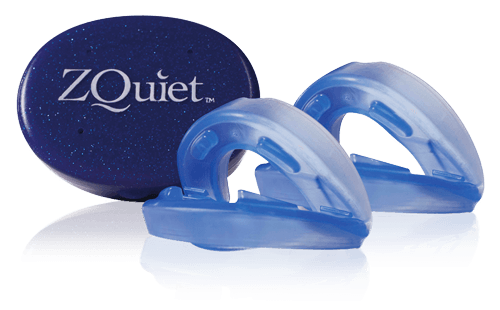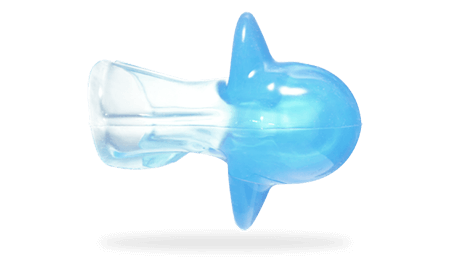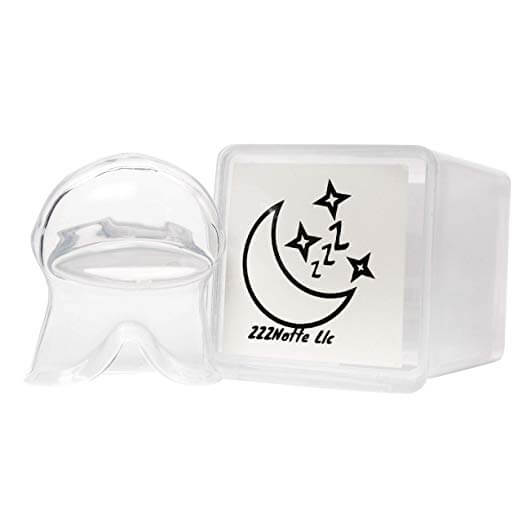Jump to:
- What Is Obstructive Sleep Apnea?
- What Is a Sleep Apnea Mouthpiece?
- What Are the Different Kinds of Sleep Apnea Mouth Appliances?
- Where Can You Buy a Sleep Apnea Mouthpiece?
Do you often wake up with a headache, dry mouth or a sore throat? Do you have trouble getting up and starting your day on a high note? Are you fatigued, forgetful, irritable, or unfocused during mornings? Do you wake up exhausted and suffer from bouts of microsleep throughout the day?
If any of this sounds familiar, you might have sleep apnea. One of the main symptoms of this condition is snoring—which you might also be doing when you’re asleep! Hard to tell, unless you share your bedroom with someone and they let you know.
A popular way to deal with snoring is to use a mouthpiece for sleep apnea. A quick Google search will reveal that there are hundreds of sleep apnea mouthpiece reviews online! We’ve even done a few anti-snoring device reviews ourselves.
Do sleep apnea mouthpieces really work, though? And if they do: Are there different kinds of sleep apnea mouth appliances? What’s the best mouthpiece for sleep apnea? Where do you get them?
Let’s find out together.

What Is Obstructive Sleep Apnea?
Obstructive sleep apnea (OSA) is a condition characterized by being routinely impaired by a partial or complete blockage in a sleeper’s upper airway. This may result in snoring, improper breathing, gasping, etc. during sleep to increase air intake.
Before we do a deep dive into sleep apnea mouthpieces, it helps to understand what these devices are supposed to be for. Why is managing and treating sleep apnea so important?
Obstructive sleep apnea has to do with how you breathe during sleep. Mouth breathing and sleep apnea are closely related. Because of this, sleep apnea can also cause dry mouth and throat.
Sometimes breathing becomes so difficult that you may even stop doing it! This can lead to multiple sleep interruptions so brief that you won’t even remember them in the the morning.
The impact of sleep apnea stretches far beyond just snoring and poor breathing, though. You won’t get enough rest, sure. But there are many other health risks, too! The breathing problems can reduce oxygenation throughout the body, affecting your vital organs and overall well-being.
Untreated obstructive sleep apnea may also increase the risk of hypertension and other heart problems—like irregular heartbeats and stroke—as well as diabetes.
What Causes Obstructive Sleep Apnea?
A blockage in the airway while sleeping is a physical issue. It’s typically body parts—tongue, tonsils, soft palate, uvula, etc.—that go slack during sleep and falling back in a way that closes the path where air is supposed to flow.
Why does this happen to some people but not others? It can be just the way you are built. For example: If you have a deviated septum, smaller airways, or a bigger than usual tongue, you might be more predisposed to develop obstructive sleep apnea.
The condition is also more common in back sleepers, and overweight or obese people. Men are also more at risk compared to women. Middle-aged and older people are more likely to suffer from obstructive sleep apnea, too.
If you suspect that you may have obstructive sleep apnea, please do consult a healthcare professional and get an official diagnosis.
What Is the Best Obstructive Sleep Apnea Treatment?
Treatment can range from simple weight loss and a change in sleeping position, to using a sleep apnea mouthpiece and/or undergoing continuous positive airway pressure (CPAP) therapy. Some extreme cases may even require surgery.
It depends on how severe the condition is—which is why it is important to involve your doctor in any decision about how to deal with your obstructive sleep apnea. How can you gauge the severity of your condition when it presents itself while you are asleep?
CPAP therapy is the most common method of treatment, but it can be difficult to manage for some. The constant air delivered through the nose or mouth may feel unnatural at first, and the mask you need to wear on your face may be uncomfortable.
A CPAP machine can also be expensive without insurance—anywhere from $1000 to $4000, and maybe even more or some models—so some may be hesitant to try it out.
Some doctors may recommend an alternative for some patients that is relatively more affordable, and easier to get used to: oral appliance therapy through the use of a sleep apnea mouthpiece.
You may have come across a sleep apnea mouthpiece review or two while looking up sleep apnea online. Before you decide on which one to use, let’s find out exactly how these sleep apnea mouth appliances work.
What Is a Sleep Apnea Mouthpiece?
A mouthpiece to help with sleep apnea can come in different designs and shapes, but the purpose is the same: It is worn during sleep to keep the airway open.
What’s the best sleep apnea mouth piece for you? Again, it depends on the severity of your condition—and also your particular needs. Comfort is also a huge issue here, as well as availability.
Later on we’ll talk about comfort and availability, and how both should inform your choice of mouthpiece. For now, let’s find out how an oral appliance is designed to treat sleep apnea.
How Does a Mouthpiece to Help Sleep Apnea Work?
A sleep apnea mouth device works by moving the tongue forward to a position that won’t block air flow. Some designs do this by moving the whole lower jaw forward, while some control the tongue directly.
We go into more detail about the different kinds of mouthpieces available below.
Your cranky mouth breather days may come to an end once you start using an a sleep apnea mouthpiece, but these devices aren’t without their disadvantages.
Some designs may not allow for mouth breathing at all, which can be a problem if you suffer from allergies or have a cold. Some may prevent you from talking or drinking water after you’ve put them on. Some may even cause real complications and side effects.
These oral appliances don’t last forever, either, so you will have to replace them regularly. How often depends on the quality of the product and your usage of it—but the time period is usually between six months to two years. This is where availability comes in. Ideally, your sleep apnea mouthpiece should be fitted and created specifically for your mouth by a dentist.
But what happens if your medical insurance policy changes and fails to cover sleep apnea treatment? What if you lose your oral appliance while traveling? What if you need to replace your mouthpiece but can’t schedule an appoint with your dentist immediately?
The best sleep apnea mouthpiece for you is one that is affordable, doctor-approved, and a good fit for your lifestyle and daily routine.
Sleep Apnea Mouthpieces, Mouth Guards, Dental Splints: Are They the Same?
They are all different! The terms sometimes get used interchangeably because these three can look very similar to each other, but you can’t substitute one for the other.
Many sleep apnea mouthpieces cover the teeth and gums—just like the common mouth guard. A dental splint, on the other hand, usually doesn’t cover the gums.
A sleep apnea mouthpiece may also be called a sleep apnea mouth guard—this is correct. What’s incorrect is to simply use the term “mouth guard”, because there are different kinds for specific uses.
The most typical is the sports mouth guard, which you can find stocked at athletic stores. These are used for injury prevention and shock absorption. They do not help with sleep apnea.
A mouth guard for sleep apnea should be labeled and used as such. A mouth guard cannot be used for a condition they’re not designed to treat.
What about dental splints? They’re also known as occlusal splints or night guards, and are used to treat bruxism—jaw clenching and/or teeth grinding—or problems relating to the jaw. Again, these do not help with sleep apnea.
Sleep Apnea Mouthpieces Vs. CPAP Masks: What’s the Difference?
CPAP masks—which are used with CPAP machines—may sometimes be referred to as sleep apnea masks. They are different from sleep apnea mouthpieces, which are almost always used by themselves.
There is a surprising range of CPAP masks available in the market. You may find a whole bunch of specifically marketed options: sleep apnea masks for mouth breathers, sleep apnea masks for side sleepers, full face masks, nose masks without mouthpieces, and so on.
It’s worth noting that there are a few cases when a sleep apnea mouthpiece can also be (part of) a CPAP mask—and therefore may be synonymous to a sleep apnea mask. For certain cases, a doctor may work in conjunction with a dentist to create a custom mouth device for sleep apnea that can be directly attached to a CPAP machine.
What Are the Different Kinds of Sleep Apnea Mouth Appliances?
There are two main types of mouthpieces for sleep apnea: mandibular advancement devices (MADs) and tongue retaining devices (TRDs).
Examples of the latter can also be called tongue stabilizing devices (TSDs).
1. Mandibular Advancement Device for Sleep Apnea
Remember when we explained how sleep apnea mouthpieces work earlier? MADs are the ones designed to move the lower jaw—the mandible—forward. This moves the tongue forward, too, because the tongue is connected to the lower jaw. You pop it in place like you would a mouth guard, and you’re set.

Apart from keeping your airway open, MADs can also improve the strength of your airway muscles. They are designed to keep your jaw at a certain configuration, and so naturally increase activity of your airway and tongue muscles.
However, many sleep apnea mouthpiece complications are really mandibular advancement device side effects. Some may cause teeth shifting or arthralgia (joint pain). Developing temporal mandibular joint arthritis (TMJ) is also a real issue.
2. Tongue Retaining/Stabilizing Device for Sleep Apnea
A TRD or TSD is a sleep apnea tongue mouthpiece. They are said to be less likely to cause oral appliance therapy complications, compared to MADs as they don’t involve the lower jaw. But they are normally more cumbersome and far less comfortable. Unlike MADs that usually go completely in your mouth, TRDs typically have a part the protrudes beyond your teeth.
It may take much longer for you to adjust to having them on as you sleep, and it can take months before you are able to wear one comfortably.

Both MADs and TRDs may cause excessive salivation during the first few uses. The former may make teeth and gums a little sensitive, and the latter may do the same for the tongue. But all TRDs, by design, will make it near impossible for you to talk once you put them on.
Where Can You Buy a Sleep Apnea Mouthpiece?
You may be surprised to find that sleep apnea mouthpieces are available in most physical pharmacy store chains and large online retailers! Prescription-only models may be easier to source directly from your doctor or dentist, though.
Yes, you will be able to find a sleep apnea mouth guard at your local CVS, Walgreens or even Walmart. And of course, you can always check Amazon or your preferred online store.
There really isn’t one universal name for this product, so you need to look carefully. Apart from a mouthpiece or a mouth guard, an oral appliance for sleep apnea may also be called a snoring aid or an anti-snoring device. You may also see terms like “snoring solution” or “snore stopper” being appended to different product names.
Are There OTC Sleep Apnea Mouthpieces?
Yes! It is fairly easy to find and purchase a sleep apnea mouth guard over the counter.
The most common OTC sleep apnea oral device is the boil-and-bite MAD. Products under this category are as popular as they as affordable, making for almost total market domination. They’re also known as DIY sleep apnea mouthpieces, because you mold them to the shape of your mouth yourself.
These over the counter mouthpieces for sleep apnea are usually bulkier than prescription counterparts. If you have a very small mouth, an adjustment period may not be enough! Some of these boil-and-bite products may actually be impossible to use. A lot of these products note this limitation in their info.
When choosing an OTC solution, it’s important to make sure that the one you pick is an FDA approved sleep apnea mouthpiece. These appliances stay in your mouth for hours on end and are for nightly use. They should go through testing and regulation, and they should hold up to FDA standards.
Also: Make sure that the OTC mouthpiece you choose is actually for sleep apnea or anti-snoring. There are a ton of boil-and-bite options out there that are marketed for teeth-grinding only.

Below are two OTC boil-and-bite sleep apnea MAD favorites of ours. Both are FDA approved and BPA free:
- Splurge with the Slumber Pro Anti Snoring Mouthpiece and Bruxism Guard ($32.88 on Amazon). It’s made of self-molding white polymer. The opaque material makes it easy for you to see any building that needs to be cleaned. You can also adjust the Slumber Pro’s lower jaw adjustment a millimeter at a time so you can find the perfect fit.
- Save with the SleepMore Sleep Aid Device ($17.98 on Amazon). You can repeat the molding process several times until you get the correct fit for your mouth. A notable plus: As affordable as it is, it still comes with a 100% money back guarantee.
How do you use a boil-and-bite mouthpiece? The name should give you an idea. These sleep apnea mouth guards are made from a thermoplastic material that becomes soft and prone to molding when you expose it to boiling water.
They are already shaped like a mouth guard, so it’s easy to insert one in your mouth and bite down after you’ve submerged the boil and bite product in hot water for the indicated time period. You’re supposed to move your lower jaw slightly forward at this point, and then hold that position for a minute or so. Then you take the mouthpiece out and let it cool to set its shape.
Can’t seem to find a boil-and-bite sleep apnea MAD that works for you? You may want to try an over the counter TRD instead.

Below are two OTC sleep apnea TRD favorites of ours. Both are FDA approved and BPA free:
- Splurge with the Snore Solvers Tongue Retainer Anti-Snoring Device ($16.99 on Amazon). Wash, insert your tongue, squeeze the tip to induce light suction, and that’s it. Snore Solvers notes that if it feels painful or too tight, it may be a case of too much suction applied. This product also comes with a 30-day money back guarantee.
- Save with the ZzzNotte Anti-Snoring Device (Check deal on Amazon). Same instructions as above, though this one is not only more affordable, but also comes with a lifetime warranty.
Can You Buy a Prescription Dental Mouthpiece for Sleep Apnea Online?
Yes. While a custom-fit dental mouth guard for sleep apnea is the best choice if you’re on a prescription, there are some doctor-approved options that you can purchase through online shopping.
This is a tricky topic! The FDA actually states that mouthpieces for snoring should be prescription only, although some can be cleared by them for OTC distribution. Even sleep apnea mouth devices from brands promoting the fact that you need a prescription to use them—like ZQuiet, for example—can be easily purchased on Amazon.
There really is no way to enforce this. Do we expect Amazon to require a scanned or faxed doctor’s prescription for each purchase? Of course not. The best we can do is to be honest and to have our own well-being in mind when we choose a sleep apnea mouth guard.
In our research we’ve found that the most common reason people opt to go for OTC sleep apnea solutions over prescription and custom mouthpieces is the price difference. That is 100% understandable! Also, it is probably 100% why OTC variants exist in the first place.
Sleep Apnea Mouthpieces: The Bottom Line
You may want to start with with an OTC dental mouthpiece if you are just beginning to explore obstructive sleep apnea treatment options, or if you believe that you simply have an occasional snoring problem. Self-medication is never good, though.
As with anything medically related, Good Night’s Rest recommends that you consult your doctor before making any big decisions. Don’t add something to your daily routine without having it checked out by a health professional!
Doctor approval—or input, at the very least—is especially important when it comes to sleep apnea mouthpieces, as some of them may lead to negative side effects if used incorrectly.
Worried about the cost? As a compromise, you can show your doctor some affordable OTC mouthpieces and let them know that these are your options. You can also give them a price range and straight up let them know that CPAP therapy isn’t on the table unless your financial or insurance situation changes.